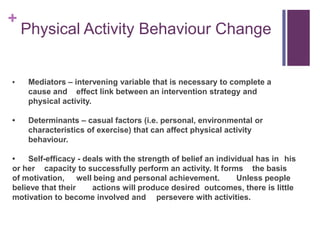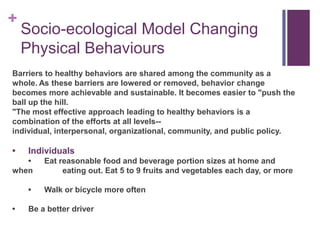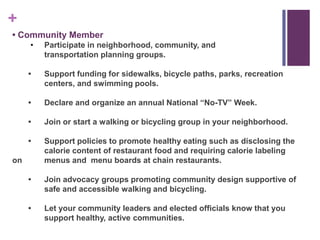Whi u3 changing physical activity behaviour
- 1. + Unit 3: Physical activity participation and physiological performance
- 2. + Area of Study 1ŌĆō Monitoring and Promotion of Physical Activity Changing Physical Activity Behaviour
- 3. + Physical Activity Behaviour Change ŌĆó Mediators ŌĆō intervening variable that is necessary to complete a cause and effect link between an intervention strategy and physical activity. ŌĆó Determinants ŌĆō casual factors (i.e. personal, environmental or characteristics of exercise) that can affect physical activity behaviour. ŌĆó Self-efficacy - deals with the strength of belief an individual has in his or her capacity to successfully perform an activity. It forms the basis of motivation, well being and personal achievement. Unless people believe that their actions will produce desired outcomes, there is little motivation to become involved and persevere with activities.
- 4. + Physical Activity Promotion ŌĆó Effective physical activity interventions target changes at the following levels:- ŌĆó individual ŌĆó social ŌĆó physical environment ŌĆó policy ŌĆó Strategies to Promote Physical Activity Individual Level Population Level Print and web based Environmental change material Counselling Policy Process of change Mass media
- 5. + Physical Activity Behavioural Change Cognitive Strategies Behavioural Strategies Increasing knowledge Substituting alternatives Awareness of risks Enlisting social support Concern about impact to others Rewarding yourself Understanding benefits Committing yourself Awareness of opportunities to Reminding yourself be active
- 6. + Print and Web-based Media ŌĆó
- 7. + Counseling ŌĆó Counseling strategies:- ŌĆó assessing motivational readiness ŌĆó matching process of change with motivational readiness ŌĆó contracting ŌĆó enlisting social support ŌĆó reminder systems ŌĆó gradual programming ŌĆó tailoring
- 8. + Socio-ecological Model ŌĆóThe socio-ecological model recognises the interwoven relationship that exists between the individual and their environment. While individuals are responsible for instituting and maintaining the lifestyle changes necessary to improve health, individual behaviour is determined to a large extent by social environment, e.g. community norms and values, regulations and policies. ŌĆó In order to increase physical activity levels health promotion efforts need to focus not only on the behaviour choices of each individual, but also on factors that influence those choices. These factors operate our of several spheres of influence including:- ŌĆó the individual ŌĆó social environment ŌĆó physical environment ŌĆó policy components
- 9. + Socio - ecological Model Recognizing that groups Developing and enforcing state and provide social identity and local policies that can increase support, interpersonal beneficial health behaviors. interventions target groups, Developing media campaigns that such as family members or promote public awareness of the peers. health need and advocacy for change. Social Individual Policy Motivating change in individual behavior by increasing knowledge, or influencing attitudes or challenging beliefs. Environmenta Changing the physical environment or the l environment of an organization (e.g. workplace, school, or another type of community organization) to support behavior change.
- 10. + Socio-ecological Model Changing Physical Behaviours Barriers to healthy behaviors are shared among the community as a whole. As these barriers are lowered or removed, behavior change becomes more achievable and sustainable. It becomes easier to "push the ball up the hill. "The most effective approach leading to healthy behaviors is a combination of the efforts at all levels-- individual, interpersonal, organizational, community, and public policy. ŌĆó Individuals ŌĆó Eat reasonable food and beverage portion sizes at home and when eating out. Eat 5 to 9 fruits and vegetables each day, or more ŌĆó Walk or bicycle more often ŌĆó Be a better driver
- 11. + ŌĆó Parents ŌĆó Serve as good role models by practicing healthy eating habits and by being physical active every day. ŌĆó Make sure tasty, attractive fruits and vegetables are available for meals and snacks at home and when eating out. ŌĆó Set limits on television viewing. ŌĆó Limit access to sugar-sweetened drinks. ŌĆó Work with your childrenŌƤs schools to develop policies regarding: vending machines, use of foods as rewards in classrooms, adequate lunch and recess time, daily PE, safe walking and bicycling routes to school. ŌĆó Organize Walk to School Day events in your childrenŌƤs schools.
- 12. + ŌĆó Employers ŌĆó Offer walk/bike/transit incentives like bicycle parking and transit passes. ŌĆó Provide exercise and changing facilities at work. ŌĆó Post signs near elevators encouraging people to take the stairs. ŌĆó Make the stairway a safe and inviting place. ŌĆó Support community-wide events that promote physical activity. ŌĆó Set standards for foods served at cafeterias, in vending machines, and at meetings. ŌĆó Use price incentives in the cafeteria and in vending machines to increase consumption of healthy foods.
- 13. + ŌĆó Community Member ŌĆó Participate in neighborhood, community, and transportation planning groups. ŌĆó Support funding for sidewalks, bicycle paths, parks, recreation centers, and swimming pools. ŌĆó Declare and organize an annual National ŌĆ£No-TVŌĆØ Week. ŌĆó Join or start a walking or bicycling group in your neighborhood. ŌĆó Support policies to promote healthy eating such as disclosing the calorie content of restaurant food and requiring calorie labeling on menus and menu boards at chain restaurants. ŌĆó Join advocacy groups promoting community design supportive of safe and accessible walking and bicycling. ŌĆó Let your community leaders and elected officials know that you support healthy, active communities.
- 14. + ŌĆó Architects, Community and Transportation Planners ŌĆó Design buildings where stairs are visible, accessible and safe. ŌĆó Adjacent to buildings, provide sidewalks, convenient bicycle parking and safe connectivity to public transit. ŌĆó Consider public transit, sidewalks, bicycle lanes, and bicycle paths for walking and bicycling to be as essential as streets and roads for vehicles. ŌĆó Design frequent and safe street crossings. ŌĆó Design neighborhoods and communities where children and adults can easily and safely travel between home, work, school, retail establishments, parks and recreation facilities on foot and bicycle.
- 15. + Community Leaders and Policy Makers ŌĆó ŌĆó Consider health consequences along with financial impact when developing school policies such as offering daily PE, promoting walking and bicycling to school, or district support for school meal programs. ŌĆó Prioritize funding for increasing and improving pedestrian and bicycle facilities in communities. ŌĆó Consider public health impacts in land-use planning decisions such as siting of schools, development of mixed-use neighborhoods. ŌĆó Consider zoning regulations. ŌĆó Assure access to full-service grocery stores in all neighborhoods and limit density of fast food restaurants. ŌĆó Prioritize funding for effective public health interventions to increase physical activity, promote healthy eating, and reduce obesity and chronic diseases.
- 16. + Top 10 Causes of Death Worldwide Based on data from World Health Organisation Fact Sheet No 310: 2008 World Deaths in Millions % of Deaths Coronary heart disease 7.2 12.2 Stroke and other 5.71 9.7 cerebrovascular diseases Lower respiratory infections 4.18 7.1 Chronic obstructive 3.02 5.1 pulmonary disease Diarrhoeal diseases 2.16 3.7 HIV/AIDS 2.04 3.5 Tuberculosis 1.46 2.5 Trachea, bronchus, lung 1.32 2.3 cancers Road traffic accidents 1.27 2.2 Prematurity and low birth 1.18 2.0 weight
- 17. + WHO Library Cataloguing-in-Publication Data Global health risks: mortality and burden of disease attributable to selected major risks. 2009
- 18. + Lifestyle Diseases
- 19. + Physical Activity Measurement ’ü« Physical activity measurement has several important uses, in informing the overall health promotion effort and is used in: ŌĆó research, to understand the relationship between physical activity and a range of physical health and mental health outcomes. ŌĆó the monitoring and surveillance of physical activity levels in and among populations. ŌĆó understanding the correlates and determinants of physical activity, and to explain why some people or groups are more active than others. ŌĆó measuring the impact and effectiveness of health promotion programmes and interventions designed to increase physical activity. ŌĆó providing a sound and strong evidence base for broader initiatives in health promotion policy and practice.
- 20. + Measurable Components of Physical Activity ’ü« Physical activity is a set of complex physical behaviours, with possible measurements made of its duration, frequency, intensity or setting. ŌĆó How often activity is undertaken: measures of frequency ŌĆó Duration of physical activity per session: expressed as total time per day ŌĆó Intensity of activity: activities may be classified as light, moderate or vigorous based on their assigned energy expenditure values (ŌĆ×METŌƤ values or Multiples of Basal Resting Energy) ŌĆó Type: specific physical activity or sport performed ŌĆó Domains or settings where the physical activity is performed: leisure time (organised ŌĆō non organised), occupational, domestic, active commuting, incidental and sedentary.
- 21. + Metabolic Equivalent (METS) Intensity METS Energy % Max HR Examples of Classification Expended Activities (kJ/min Low Intensity <3 <15 <50 Walking slowly, golf, gardening, household chores, sitting Moderate 3-6 15-30 50-70 Surfing, Intensity performing massage, social badminton Vigorous 7+ 30+ 70+ Australian rules intensity football, shovelling ditches, squash
- 22. + National Activity Guidelines ’ü«0 ŌĆō 5 Years ŌĆó 0 ŌĆō 1 floor based play should be encouraged ŌĆó 1 ŌĆō 3 ŌĆō should be physically active for at least three hours each day ŌĆó 2 ŌĆō 5 ŌĆō sitting using electronic media should be limited to less than one hour per day
- 23. + National Activity Guidelines ’ü«5 ŌĆō 12 Years ŌĆó At least 60 minutes (and up to several hours) of moderate to vigorous intensity activity should be completed every day ŌĆó no more than 2 hours per day should be spent using electronic media for entertainment
- 24. + National Activity Guidelines ’ü« 12 ŌĆō 18 Years ŌĆó At least 60 minutes (and up to several hours) of moderate to vigorous intensity activity should be completed every day ŌĆó no more than 2 hours per day should be spent using electronic media for entertainment
- 25. + National Activity Guidelines ’ü« Adults 18 - 65 ŌĆó Think of movement as an opportunity, not an inconvenience ŌĆó Be active in as many ways as possible ŌĆó Put together at least 30 mins of moderate intensity activity on most, preferably all, days ŌĆó If possible enjoy some regular vigorous activity
- 26. + National Activity Guidelines ’ü« Older Adults 65+ ŌĆó Continue to be active no matter what your age ŌĆó Be active every day in as many ways as possible ŌĆó Accumulate at least 30 mins of moderate intensity activity on most, preferably all, days ŌĆó If commencing exercise for the first time begin gradually ŌĆó If maintained activity levels continue to exercise at a safe level which you are capable of maintaining
- 27. + Measuring Physical Activity ’ü« Accurate assessment of physical activity is influenced by ŌĆ£behavioural reactivityŌĆØ ŌĆō in which the use of measurement tools can change physical activity behaviours. ŌĆó Objective methods of data collection do not need the participant to process information and exists independently of what the participant thinks. Objective measures include:- - Direct observation - Pedometers - Accelerometers - Heart rate monitors ŌĆó Subjective measures of data collection require some level of cognitive or perceptual processing by the participant to create the data. These measures require participants to think about, and record, information about their physical activity levels. Subjective measure include:- ŌĆó Self Report include assessment methods such as interviews, diaries, logs and questionnaires and rely on people to estimate or recall their own activity level
- 28. + ŌĆó Accelerometers are electronic motion sensors that detect movement in a vertical plane as a combined function of the frequency and intensity of the movement. Movement counts are averaged over defined time frames, which are stored in memory and subsequently downloaded to a computer. Accelerometer
- 29. + ŌĆó Involves watching subjects behave in a particular environment such as homes, workplaces, parks or school yards. Direct Observation
- 30. + ŌĆó Heart rate monitors measures heart rate response to exercise which provides an indicator of activity that reflects physiological stress on the body. Heart Rate Monitors
- 31. + ŌĆó Pedometers assess the total number of steps taken and some models can estimate total distance travelled, time of total movement and energy expenditure. ŌĆó The benchmark number of steps for achieving health benefits is 10,000 steps. Pedometers
- 32. + ŌĆó Self Report can be divided into two basic categories:- i. Recall based approaches - obtain actual information on activity on specific days. ii. General measures - focus on typical activity behaviour and often involve a series of questions about general activity patterns. ŌĆó Global Physical Activity Questionnaire (CPAQ) ŌĆó International Physical Activity Questionnaires (IPAQ) Self Report















































































